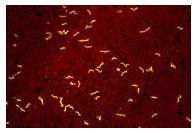Relapsing fever laboratory findings: Difference between revisions
| (4 intermediate revisions by the same user not shown) | |||
| Line 3: | Line 3: | ||
{{CMG}} | {{CMG}} | ||
==Overview== | ==Overview== | ||
The presence of [[spirochetes]] in [[Peripheral blood smear|smears of peripheral blood]], [[bone marrow]], or [[cerebrospinal fluid]] in a [[symptomatic]] person is [[diagnostic]] of [[relapsing fever]]. | |||
The [[diagnosis]] of [[relapsing fever]] is confirmed by the identification of the borrelia in the patient's [[blood]] under [[microscopy]]. Laboratory tests may also reveal mild [[anemia]] with normal to increased [[leukocyte]] count. Biochemistry may reveal Mildly increased serum [[bilirubin]] and hepatic [[aminotransferase]] level, increased [[Urea|urea nitrogen]], [[creatinine]], Elevated [[ESR]]. | |||
Slightly prolonged [[coagulation|coagulation tests]], [[PT]] and [[APTT]], as well as [[proteinuria]] or [[hematuria]], are also common | |||
==Laboratory Findings== | ==Laboratory Findings== | ||
| Line 10: | Line 11: | ||
[[Image:Peripheral blood smear from Schwan, Policastro et al.jpg|right|thumb|Peripheral blood smear from Schwan, Policastro et al 2003]] | [[Image:Peripheral blood smear from Schwan, Policastro et al.jpg|right|thumb|Peripheral blood smear from Schwan, Policastro et al 2003]] | ||
===Microscopic Diagnosis=== | |||
*The presence of [[spirochetes]] in smears of peripheral [[blood]], [[bone marrow]], or [[cerebrospinal fluid]] which stained with [[Giemsa]], May-Grünwald Giemsa, [[Wright's stain|Wright]], Wright-Giemsa, [[Field's stain|Field's]], or Diff-Quick stains, or examined under [[Darkfield microscope|dark-field]] while the patient is [[febrile]], is diagnostic of [[relapsing fever]]. Although best visualized by [[Darkfield microscope|darkfield microscopy]], the [[organisms]] can also be detected by Wright-Giemsa or [[Acridine orange|acridine orange-stained]] preparations. | |||
*The presence of spirochetes in smears of peripheral [[blood]], [[bone marrow]], or [[cerebrospinal fluid]] which stained with Giemsa, May-Grünwald Giemsa, Wright, Wright-Giemsa, Field's, or Diff-Quick stains, or examined under dark-field while patient is febrile, is diagnostic of relapsing fever. Although best visualized by darkfield microscopy, the organisms can also be detected by Wright-Giemsa or acridine orange-stained preparations. | |||
*With subsequent [[febrile]] episodes, the number of circulating [[spirochetes]] decreases, making it harder to detect [[spirochetes]] on a peripheral blood smear. Even during the initial episode [[spirochetes]] will only be seen 70% of the time. <ref name="pmid26618151">{{cite journal |vauthors=Fotso Fotso A, Drancourt M |title=Laboratory Diagnosis of Tick-Borne African Relapsing Fevers: Latest Developments |journal=Front Public Health |volume=3 |issue= |pages=254 |date=2015 |pmid=26618151 |pmc=4641162 |doi=10.3389/fpubh.2015.00254 |url=}}</ref> | |||
===Molecular Diagnosis and serology=== | |||
*Antibody tests and [[PCR]] is available through public health laboratories and some private laboratories. Although there are [[false-positive]] and [[false-negative]] results. | |||
===Other laboratory findings=== | |||
More common: | More common: | ||
*Normal to increased white blood cell count with a left shift towards immature cells | *Normal to increased [[white blood cell count]] with a left shift towards immature cells | ||
*Mild to moderate [[thrombocytopenia]] | *Mild to moderate [[thrombocytopenia]] | ||
*Mild anemia | *Mild [[anemia]] | ||
*Elevated [[ESR]] | *Elevated [[ESR]] | ||
Less common: | Less common: | ||
*Mildly increased serum [[bilirubin]] and hepatic aminotransferase level | *Mildly increased serum [[bilirubin]] and hepatic [[aminotransferase]] level | ||
*increased urea nitrogen, creatinine | *increased [[Urea|urea nitrogen]], [[creatinine]] | ||
*Slightly prolonged coagulation tests, [[PT]] and [[APTT]], as well as proteinuria or hematuria, are also common | *Slightly prolonged [[coagulation|coagulation tests]], [[PT]] and [[APTT]], as well as [[proteinuria]] or [[hematuria]], are also common | ||
==References== | ==References== | ||
Latest revision as of 01:20, 25 September 2020
|
Relapsing fever Microchapters |
|
Diagnosis |
|---|
|
Treatment |
|
Case Studies |
|
Relapsing fever laboratory findings On the Web |
|
American Roentgen Ray Society Images of Relapsing fever laboratory findings |
|
Risk calculators and risk factors for Relapsing fever laboratory findings |
Editor-In-Chief: C. Michael Gibson, M.S., M.D. [1]
Overview
The presence of spirochetes in smears of peripheral blood, bone marrow, or cerebrospinal fluid in a symptomatic person is diagnostic of relapsing fever. The diagnosis of relapsing fever is confirmed by the identification of the borrelia in the patient's blood under microscopy. Laboratory tests may also reveal mild anemia with normal to increased leukocyte count. Biochemistry may reveal Mildly increased serum bilirubin and hepatic aminotransferase level, increased urea nitrogen, creatinine, Elevated ESR. Slightly prolonged coagulation tests, PT and APTT, as well as proteinuria or hematuria, are also common
Laboratory Findings


Microscopic Diagnosis
- The presence of spirochetes in smears of peripheral blood, bone marrow, or cerebrospinal fluid which stained with Giemsa, May-Grünwald Giemsa, Wright, Wright-Giemsa, Field's, or Diff-Quick stains, or examined under dark-field while the patient is febrile, is diagnostic of relapsing fever. Although best visualized by darkfield microscopy, the organisms can also be detected by Wright-Giemsa or acridine orange-stained preparations.
- With subsequent febrile episodes, the number of circulating spirochetes decreases, making it harder to detect spirochetes on a peripheral blood smear. Even during the initial episode spirochetes will only be seen 70% of the time. [1]
Molecular Diagnosis and serology
- Antibody tests and PCR is available through public health laboratories and some private laboratories. Although there are false-positive and false-negative results.
Other laboratory findings
More common:
- Normal to increased white blood cell count with a left shift towards immature cells
- Mild to moderate thrombocytopenia
- Mild anemia
- Elevated ESR
Less common:
- Mildly increased serum bilirubin and hepatic aminotransferase level
- increased urea nitrogen, creatinine
- Slightly prolonged coagulation tests, PT and APTT, as well as proteinuria or hematuria, are also common
References
- ↑ Fotso Fotso A, Drancourt M (2015). "Laboratory Diagnosis of Tick-Borne African Relapsing Fevers: Latest Developments". Front Public Health. 3: 254. doi:10.3389/fpubh.2015.00254. PMC 4641162. PMID 26618151.